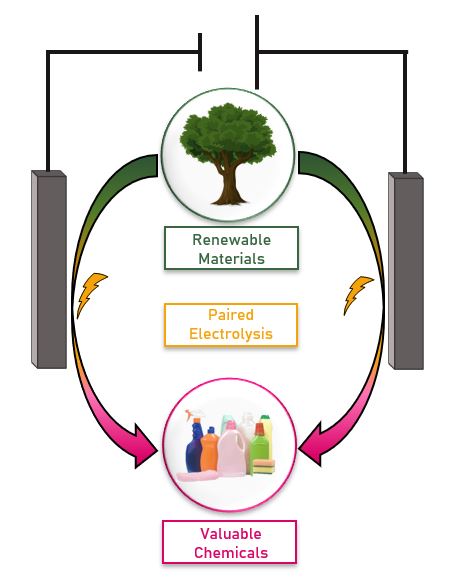Exploring the Landscape of Electrochemical Reactions and Improving Process Sustainability through Paired Synthesis
The overall vision of our research program is to decrease the reliance of the chemical industry on fossil fuels, through the development of paired electrolysis reactions. To do this, we target two types of chemical transformations with the aim of increasing process sustainability or discovering new reactivity. Specifically, we are investigating the use of electrochemical techniques for conversion of alcohols derived from biomass, as well as new strategies for electrochemical transformations of carbon dioxide in the production of chemicals such as pharmaceuticals, fuels, agrochemicals, materials and more.
Development of Paired Electrolysis Processes for Biomass-derived Alcohol Conversion
We develop innovative, cost-saving methods that pair two electrochemical reactions to extract value-added chemicals from biomass via simultaneous reductive and oxidative processes. To do this, we apply an iterative design approach, wherein mechanistic studies are conducted concurrently with optimization, to guide design of the electrolysis system towards high productivity. The end result will be sustainable green production of hydrocarbons, alcohols and aldehydes – motifs commonly found in both bulk and fine chemicals. By exploring the landscape of electrochemical biomass conversion, we can help shift the focus of the chemical industry from fossil fuels towards more sustainable manufacturing processes.
Design of Paired Electrochemical Carbon Capture Methods
An objective of the Baker lab is to increase the economic value and sustainability of electrochemical reductive carbon capture and utilization processes by pairing with productive oxidation reactions. Two methods for electrochemical conversion of CO2 will be investigated: the direct reduction of CO2 to small molecules, and the incorporation of CO2 into organic compounds via electrochemical carboxylation reactions. The products of these systems – carboxylic acids, carbonates and isocyanates – find use primarily in the production of food or plastics. Reactor design plays an important role in the development of these processes. Focus will be on renewably sourced substrates, such that all carbons in the product come from CO2 rather than fossil carbon feedstock. Pairing electrochemical reactions that incorporate CO2 into organic molecules improves process sustainability when building up the carbon scaffold by reducing the dependence on fossil fuels, minimizing waste, and increasing efficiency.

